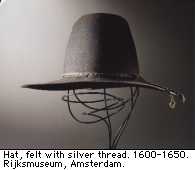 Many
times a day, gentlemen's fur felt hats played a vital role in the
socially pivotal ceremonies of greeting other people - both indoors
and outdoors. Vermeer undoubtedly owned one or more hats but in the
1676 inventory they have been left out.
Many
times a day, gentlemen's fur felt hats played a vital role in the
socially pivotal ceremonies of greeting other people - both indoors
and outdoors. Vermeer undoubtedly owned one or more hats but in the
1676 inventory they have been left out. Many
times a day, gentlemen's fur felt hats played a vital role in the
socially pivotal ceremonies of greeting other people - both indoors
and outdoors. Vermeer undoubtedly owned one or more hats but in the
1676 inventory they have been left out.
Many
times a day, gentlemen's fur felt hats played a vital role in the
socially pivotal ceremonies of greeting other people - both indoors
and outdoors. Vermeer undoubtedly owned one or more hats but in the
1676 inventory they have been left out.
We do however come across a lead hat weight.
This hat is an example of the type of hat Vermeer must have owned, made either of fur felt, decorated with silver plaited thread (Netherlands, c.1600-1650). This one is traditionally said to have been worn by Hendrik Casimir, Count of Nassau Dietz (1612-1640). Color plate p. 48 in the bilingual book by Bianca M. du Mortier, Chapeau Chapeaux Hoeden 1650-1960, 40 hoeden uit de verzameling van het Rijksmuseum; Chapeau Chapeaux Hats 1650-1960, 40 hats from the collection of the Rijksmuseum, Rijksmuseum, Amsterdam, 1997.
p. 73. Praying is done with a bare head; take your hat off.
p. 96. Only take your hat off the very first time when offering somebody food.
p. 107. Take your hat off whan an esteemed person toasts on somebody's health - or at your own health; or when he addresses you. Make sure you empty your mouth when answering.
Literature: Jacob Graal [author and publisher], De Hoofsche Welleventheid en Loffelijke Welgemaniertheid, By alle voortreffelijke Luiden in Nederland Gebruykelyk [...] Jacob Graal. 1733.
Note: Hat in Rijksmuseum photo 18x24 (no F number, photo in folder NG Kleding) NM 1098, 1097, Z31, Z32, 1110.
Vermeer house inventory are other missing objects.
Note: Photo Copyright Rijksmuseum Foundation. The Rijksmuseum has graciously assisted in this project Digital Home of Johannes Vermeer. The author was given permission to make a selection in the vast photo archive and this material has been made available by the Rijksmuseum.
This object was NOT part of the Vermeer-inventory as listed by the clerk working for Delft notary public J. van Veen. He made this list on February 29, 1676, in the Thins/Vermeer home located on Oude Langendijk on the corner of Molenpoort. The painter Johannes Vermeer had died there at the end of December 1675. His widow Catherina and their eleven children still lived there with her mother Maria Thins.
The transcription of the 1676 inventory, now in the Delft archives, is based upon its first full publication by A.J.J.M. van Peer, "Drie collecties...", Oud Holland, 1957, pp. 98-103. My additions and explanations are added in square brackets [__]. Dutch terms have been checked against the world's largest language dictionary, the Dictionary of the Dutch Language (Woordenboek der Nederlandsche Taal , or WNT), which was begun by De Vries en Te Winkel in 1882.
This page forms part of a large encyclopedic site on Vermeer and Delft. Research by Drs. Kees Kaldenbach (email). A full presentation is on view at johannesvermeer.info.
Launched December, 2002; Last update March 2, 2017.
Back to the Welcome page: click Welcome.